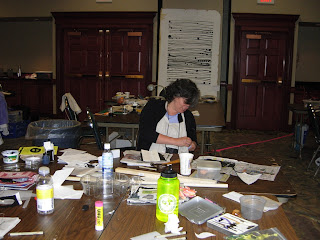 During the course of the workshop we made marks on paper and fabric using a variety of tools -- fat soft graphite sticks, India ink, tjantings and wax and bleach discharge, awls and hammers, felt-tip pens, embroidery thread and stitching. We attached brushes to dowels and created gestural lines using our dominant and non-dominant hands. Here's classmate Judy Rush working. On the wall behind her you can see one of the large line paintings a class member did with the brush tied to long dowel exercise. These pieces were truly expressive, unique and individual.
During the course of the workshop we made marks on paper and fabric using a variety of tools -- fat soft graphite sticks, India ink, tjantings and wax and bleach discharge, awls and hammers, felt-tip pens, embroidery thread and stitching. We attached brushes to dowels and created gestural lines using our dominant and non-dominant hands. Here's classmate Judy Rush working. On the wall behind her you can see one of the large line paintings a class member did with the brush tied to long dowel exercise. These pieces were truly expressive, unique and individual.
You can see more of the dowel stick and India ink paintings below, along with a seldom seen photo of Dorothy doing her impression of a runway diva. The 21 students in our class each embroidered expressive marks or words on a t-shirt for Dorothy to thank her on the last day of class. She put it right on and modeled it that last morning of class. Everyone crowded around to take photos and cheered her on to do runway poses for all the flashing cameras.

















